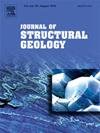The impact of hydrothermal silicification on fault zone porosity and permeability: insights from the Kornos-Aghios Ioannis normal fault, Lemnos Island, Greece
IF 2.9
2区 地球科学
Q2 GEOSCIENCES, MULTIDISCIPLINARY
引用次数: 0
Abstract
In fault zones, silica-bearing hydrothermal fluids may strongly affect petrophysical and mechanical properties of rocks with significant implications on fluid storage and flow potential. However, it is extremely difficult to predict the geometry and petrophysical properties of silicified rocks around km-long fault zones affecting reservoirs. The Kornos-Aghios Ioannis Fault (KAIF) is a 10-km long silicified extensional fault system juxtaposing volcanic rocks against turbidite sandstones. In this study, we investigate the distribution, petrophysics and mineralogy of silicified rocks through a multi-analytical approach that combines X-ray diffraction analysis, Hg-intrusion porosimetry, digital image analysis, X-ray micro-computed tomography and unsteady-state gas permeametry. Silicification is mostly localized in the footwall sandstones and extends 50–300 m from the master fault. The porosity of silicified fault cores and silicified sandstones varies over a wide range (1–13 %) depending on the degree of post-silicification dissolution that is strongly controlled by the mineralogy. However, the permeability of silicified rocks always decayed by 2–3 orders of magnitude with respect to pristine host rocks. In silicified volumes, permeability drops imparted by cementation are partially counterbalanced by higher fracture density and connectivity because of increased rock brittleness. Our results show that hydrothermal silicification along fault zones may severely degrade reservoir quality in the surrounding areas, where its effect can be locally counterbalanced by an excess permeability produced by silica dissolution, fractures, and subsidiary faults. However, the intensity and extension of silicification and dissolution are spatially variable, controlling the along-strike distribution of potentially sealing and non-sealing areas.
热液硅化作用对断裂带孔隙度和渗透率的影响:来自希腊利姆诺斯岛Kornos-Aghios Ioannis正断层的启示
在断裂带,含硅热液会强烈影响岩石的物理力学性质,对流体的储存和流动潜力产生重要影响。然而,对影响储层的长千米断裂带周围硅化岩的几何和岩石物理性质进行预测是极其困难的。Kornos-Aghios Ioannis断裂(KAIF)是一条长10公里的硅化伸展断裂系统,火山岩与浊积砂岩并置。在本研究中,我们通过结合x射线衍射分析、汞侵入孔隙度测量、数字图像分析、x射线微计算机断层扫描和非稳态气体渗透率测量等多种分析方法,研究了硅化岩的分布、岩石物理和矿物学。硅化作用主要集中在下盘砂岩中,向主断层延伸50 ~ 300 m。硅化断层核和硅化砂岩的孔隙度变化范围很广(1 - 13%),这取决于硅化后溶解的程度,而硅化后溶解受矿物学的强烈控制。然而,硅化岩的渗透率总是相对于原始寄主岩衰减2-3个数量级。在硅化体积中,胶结作用带来的渗透率下降被岩石脆性增加导致的更高裂缝密度和连通性部分抵消。研究结果表明,沿断裂带的热液硅化作用可能会严重降低周围地区的储层质量,其影响可被二氧化硅溶解、裂缝和附属断层产生的过量渗透率局部抵消。然而,硅化作用和溶蚀作用的强度和扩展在空间上是可变的,控制着潜在封闭区和非封闭区沿走向的分布。
本文章由计算机程序翻译,如有差异,请以英文原文为准。
求助全文
约1分钟内获得全文
求助全文
来源期刊

Journal of Structural Geology
地学-地球科学综合
CiteScore
6.00
自引率
19.40%
发文量
192
审稿时长
15.7 weeks
期刊介绍:
The Journal of Structural Geology publishes process-oriented investigations about structural geology using appropriate combinations of analog and digital field data, seismic reflection data, satellite-derived data, geometric analysis, kinematic analysis, laboratory experiments, computer visualizations, and analogue or numerical modelling on all scales. Contributions are encouraged to draw perspectives from rheology, rock mechanics, geophysics,metamorphism, sedimentology, petroleum geology, economic geology, geodynamics, planetary geology, tectonics and neotectonics to provide a more powerful understanding of deformation processes and systems. Given the visual nature of the discipline, supplementary materials that portray the data and analysis in 3-D or quasi 3-D manners, including the use of videos, and/or graphical abstracts can significantly strengthen the impact of contributions.
 求助内容:
求助内容: 应助结果提醒方式:
应助结果提醒方式:


